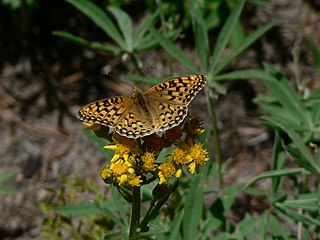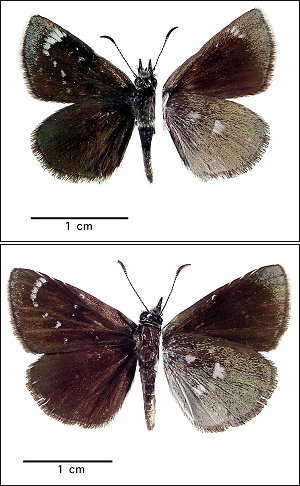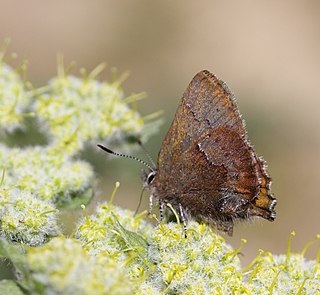
Papilio multicaudata, the two-tailed swallowtail, is a species of the family Papilionidae found in western North America from British Columbia to Central America.

Speyeria zerene, the zerene fritillary, is a butterfly found in the western portions of the United States and Canada. The species was first described by William John Swainson in 1827.

The great spangled fritillary is a North American butterfly of the family Nymphalidae.

Myrtle's silverspot is a medium-sized butterfly in the brush foot family (Nymphalidae), an endangered subspecies of the zerene fritillary. It is endemic to California, where it is known from only about four locations just north of the San Francisco Bay Area, including two at Point Reyes National Seashore. Its wingspan is approximately 2.2 inches (56 mm). The upper surfaces of the wings are golden brown with numerous black spots and lines. The undersides are brown, orange and tan with black lines and silver and black spots. Larvae are dark colored with many sharp branching spines on their backs. Myrtle's silverspot is larger and paler than the closely related Behrens' silverspot, which is now limited to the vicinity of Point Arena in Mendocino County. Myrtle's silverspot is also closely related to the Oregon silverspot.

Speyeria, commonly known as greater fritillaries, is a genus of butterflies in the family Nymphalidae commonly found in North America, Europe, and Asia. Some authors used to consider this taxon a subgenus of Argynnis, but it has been reestablished as a separate genus in 2017.

The Aphrodite fritillary is a fritillary butterfly, from North America.

Speyeria atlantis, the Atlantis fritillary, is a butterfly of the family Nymphalidae of North America. It is from the Avalon Peninsula of Newfoundland and Labrador to northern British Columbia, across the northern United States south as far as Colorado and West Virginia. It resides as far north as James Bay. The species is listed as endangered in Connecticut.

Speyeria callippe, the callippe fritillary, is a North American species of butterflies in the brush-footed family Nymphalidae.

Speyeria coronis, the Coronis fritillary, is a butterfly of the family Nymphalidae of North America. It is common from Baja California to Washington and east to Colorado and western South Dakota and once reported in Alberta.

Ochlodes sylvanoides, the woodland skipper, is a butterfly of the family Hesperiidae. It is found in North America from British Columbia south to southern California, east to Montana, Colorado and Arizona.

Euphilotes battoides, the square-spotted blue or buckwheat blue, is a species of butterfly of the family Lycaenidae.

Hesperopsis libya, the Mojave sootywing, Mohave sootywing, Great Basin sootywing or Lena sooty wing, is a butterfly of the family Hesperiidae. It is found in North America from eastern Oregon east to Montana and south to southern California, Arizona, and north-western Mexico including Baja California. Its habitats include alkalai flats, sagebrush desert, desert hills, shale barrens, watercourses, and ravines.

Callophrys mossii, commonly known as Moss's elfin, stonecrop elfin or Schryver's elfin, is a species of butterfly native to North America in the family Lycaenidae. It is found from British Columbia south to southern California and east to Wyoming and Colorado in isolated populations. The habitat consists of rocky outcrops, woody canyons and cliffs.

Satyrium saepium, the hedgerow hairstreak, is a butterfly of the family Lycaenidae. It is found in western North America, from British Columbia south through California into Baja California and east through northern Arizona to northern New Mexico, Colorado and Montana.
Speyeria carolae, or Carole's fritillary, is a butterfly in the family Nymphalidae. It was described by Cyril Franklin dos Passos and Lionel Paul Grey in 1942 and is found in North America, where it has only been recorded from the Charleston Mountains of Clark County, Nevada. The habitat consists of mountain slopes, foothills and forest openings.

Speyeria nokomis, the nokomis fritillary, is a species of fritillary in the family of butterflies known as Nymphalidae. It is found in North America.

Lycaena editha, known generally as the Edith's copper or great gray copper, is a species of copper in the butterfly family Lycaenidae. It is found in North America.















